Comforter
Are Comforters Safe to Sleep With
Curious about whether comforters are safe for sleep?

Comforters can be safe to sleep with if used correctly. To ensure safety, avoid covering your face while sleeping. For infants, wait until they are at least 12 months old before allowing them to sleep with a comforter. Choose one that does not have small parts or ties. Make sure to always supervise during sleep. Start introducing the comforter during the day from 4 months old and include it in bedtime routines from 6 months onwards. Be mindful of potential allergic reactions and overheating. Opt for lightweight, breathable options. For more detailed guidelines on comforter safety and other safe bedding alternatives, please explore further information available.
Key Takeaways
- Introduce comforters from 4-6 months under supervision.
- Choose comforters without small parts or ties.
- Avoid leaving babies unattended with comforters before 12 months.
- Opt for lightweight, breathable bedding to prevent overheating.
- Wash comforters regularly to reduce allergens.
Safety Concerns With Comforters

We must be mindful of the safety concerns associated with sleeping with comforters, particularly when it comes to babies. Covering the face while sleeping with a comforter can pose risks of suffocation for infants. Safety guidelines recommend avoiding objects near the baby's face during sleep to prevent potential hazards.
Babies could accidentally roll over onto the comforter, increasing the risk of suffocation or restricted breathing. It's safer for babies to sleep without items that can cover their faces to guarantee unobstructed breathing. When considering a comforter for a baby, it's vital to prioritize safety.
Parents should be cautious of the potential dangers and make sure that the baby's sleep environment is free from suffocation risks. As babies may form attachments to their comforters, it's essential to supervise their use and gradually reduce reliance on them to promote safe sleep practices. Prioritizing safety over comfort is paramount when it comes to infants and sleep.
Guidelines for Using Comforters Safely
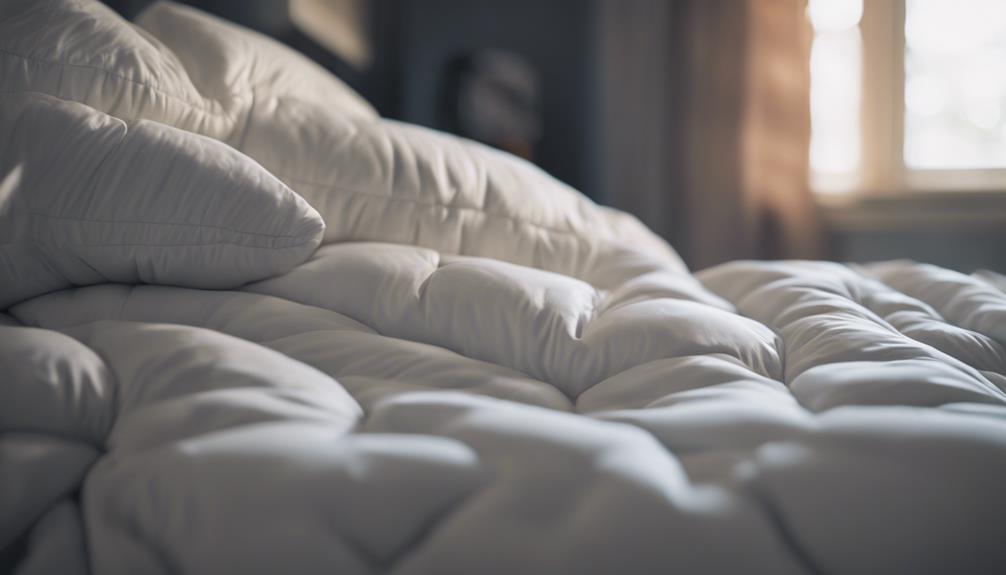
When using comforters, it is important to follow safety guidelines to guarantee a secure sleeping environment for infants and young children. Here are some key guidelines to maintain the safe use of comforters during bedtime routines and supervised sleep:
| Guidelines for Using Comforters Safely | ||
|---|---|---|
| 1. Age Appropriateness | Wait until at least 12 months before leaving a baby unattended with a comforter. | |
| 2. Safety Features | Choose a safe comforter without small parts, ties, or batteries to prevent choking hazards. | |
| 3. Supervision | Always supervise the use of comforters during sleep to ensure they do not cover the baby's face. |
Introducing a comforter from 4 months during the daytime can help develop attachment, and integrating it into bedtime routines from 6 months can provide comfort during sleep. Remember to stay informed about safe sleep practices specific to your region when introducing a comforter to your baby.
Risks of Sleeping With Comforters
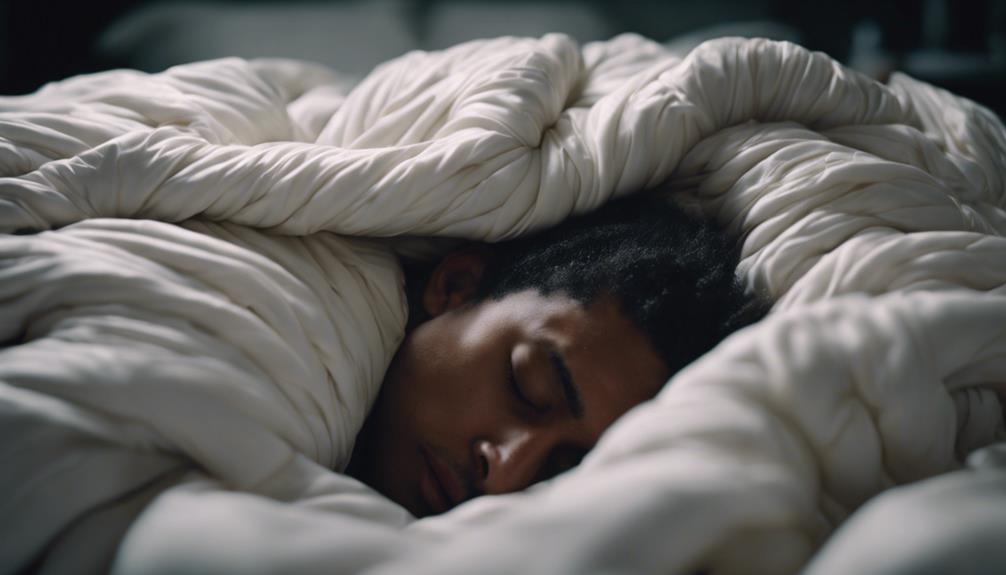
Sleeping with comforters may pose risks such as allergic reactions due to dust mites or mold, overheating concerns during sleep, and fire hazard risks if the comforter isn't flame-retardant.
These factors can potentially compromise the safety of individuals, especially babies or young children, who rely on comforters for warmth and comfort during sleep.
Understanding and addressing these risks is essential to create a safe sleep environment when using comforters.
Allergic Reactions Possibility
Regularly washing comforters in hot water can help reduce allergens and minimize the risk of allergic reactions for sensitive individuals. Dust mites, pet dander, and pollen can accumulate in comforters, potentially triggering allergies.
Materials like wool or down in comforters may aggravate allergies and respiratory issues in some people, leading to symptoms such as skin rashes, itching, sneezing, or respiratory discomfort.
To address these concerns, individuals with sensitivities can opt for hypoallergenic comforters made from synthetic materials or specially treated to resist allergens.
Overheating Concerns During Sleep
To minimize the risk of overheating during sleep, it's important to consider the type of comforter being used and its breathability. When it comes to babies, it's vital to make sure that the comforter is safe to use and doesn't pose a risk of overheating.
Heavy, thick comforters can lead to babies becoming too hot during sleep, affecting their breathing and overall well-being. Opting for lightweight, breathable bedding options is recommended to prevent overheating.
Fire Hazard Risks
When considering the safety of sleeping with comforters, one significant concern is the risk of fire hazards associated with flammable materials or placement near heat sources. Comforters made of synthetic materials can be highly flammable, increasing the potential for fire accidents during sleep.
It's important to keep comforters away from heaters, candles, or any other potential fire hazards in the sleep environment. To reduce the risk of comforters causing fires, it's advisable to follow fire safety guidelines and use fire-resistant bedding.
Regularly inspecting comforters for any signs of damage or wear can also help prevent fire hazards in the sleep area. Being mindful of these fire hazard risks when using comforters can contribute to a safer sleeping environment.
Benefits of Using Comforters

Using comforters can greatly enhance a child's emotional well-being and sense of security. These comfort items act as a bridge object, providing children with a source of emotional support and comfort, especially during times of stress or separation anxiety.
Children often form strong attachments to their comforters, which can help them self-soothe and navigate through various changes and challenges. Comforters play an essential role in helping children feel secure, allowing them to relax and feel more at ease, particularly when it comes to bedtime routines.
When children have their comforter with them, it can aid in soothing them to sleep and provide reassurance during night wakings. Overall, the benefits of using comforters go beyond just physical warmth; they contribute significantly to a child's emotional development and well-being, fostering a sense of comfort, security, and stability in their daily lives.
Recommended Age for Introducing Comforters

Introducing comforters to infants should align with safe sleep guidelines to ensure their well-being and security. The recommended age for introducing a comforter varies across different regions. In the UK, it's advised not to leave a baby unattended with a comforter until they're 12 months old.
Conversely, safe sleep guidance in Australia suggests introducing a comforter from 7 months of age. It's important to note that supervised naps with a comforter may be allowed before the age of 12 months. These guidelines aim to balance the comfort a soft object can provide with the safety considerations for the infant.
Different countries may have varying recommendations regarding the safe age for introducing a comfort item like a comforter. Following safe sleep practices is essential, which includes avoiding loose bedding or items that could cover the baby's head. Always prioritize the safety and well-being of the child when introducing comfort items into their sleep routine.
Tips for Introducing Comforters to Babies

To help your baby form a strong attachment to their comforter, consider sleeping with it for a few nights to transfer your scent onto the fabric. This process familiarizes the comforter with your scent, making it more comforting for the baby. Consistency is key in using the comforter during bedtime or calming moments to help the baby associate it with comfort. Limit the use of the comforter to specific situations like bedtime or when the baby is upset to establish its purpose clearly. It's important to be patient and give the baby time to accept the comforter, as forming an attachment may take some time. Additionally, having multiple identical comforters can be beneficial. Below is a table highlighting the benefits of having multiple identical comforters:
| Benefits of Multiple Identical Comforters |
|---|
| Ensures availability |
| Provides consistency |
| Offers a spare in case of loss or cleaning |
Alternatives to Comforters for Safe Sleep
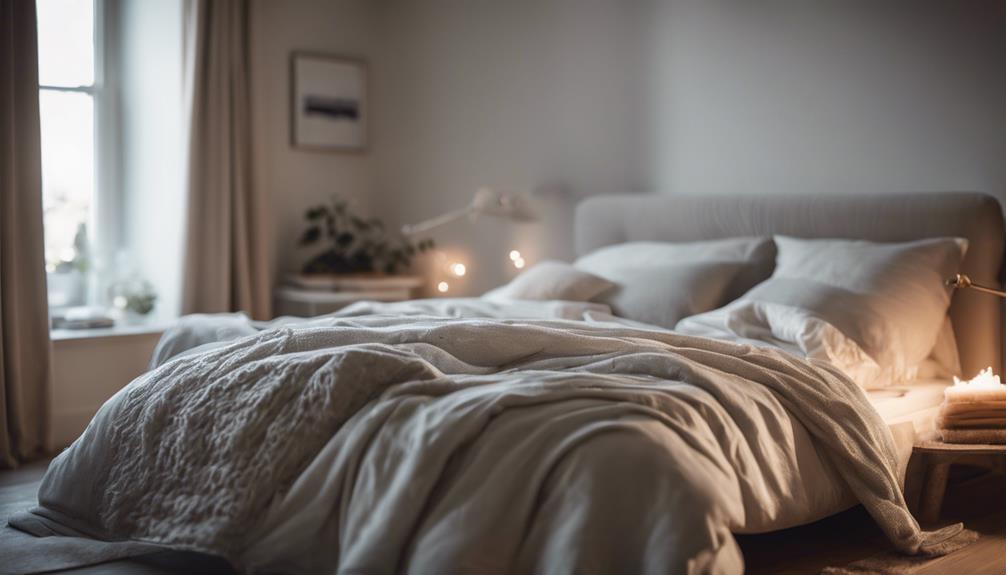
When considering alternatives to comforters for safe sleep, it's crucial to explore safer bedding options that promote a secure sleeping environment.
Look for temperature-regulating beddings that can help maintain a comfortable sleeping temperature without the need for a traditional comforter.
Additionally, hypoallergenic sleep solutions can provide a cozy and safe sleep environment for babies without the potential risks associated with comforters.
Safer Bedding Options
For safer sleep environments, it's important to explore alternative bedding options to comforters, especially for infants under 12 months old. When putting a baby to sleep, it's vital to prioritize safe sleep practices by avoiding soft toys, comfort objects, and loose bedding that can pose suffocation risks.
Instead of using comforters, consider breathable muslin squares or lightweight blankets to provide warmth without the danger of covering the baby's face during sleep. Sleep sacks or swaddles are also excellent choices as they offer a secure and cozy environment for the baby while reducing the risk of overheating or Sudden Infant Death Syndrome (SIDS).
Always remember to follow guidelines for safe sleep, such as using flat, firm surfaces and keeping the sleeping area free from hazards.
Temperature-Regulating Beddings
Exploring temperature-regulating beddings offers a safe sleep alternative to comforters, especially for creating ideal sleep conditions for infants. Beddings like bamboo or Tencel sheets are designed to help regulate temperature, preventing overheating and reducing the risk of Sudden Infant Death Syndrome (SIDS).
These breathable and moisture-wicking materials can maintain a safe sleep environment, particularly important for babies under 12 months of age. By using natural fibers that promote airflow and comfort, temperature-regulating beddings eliminate the need for additional blankets or comforters in the cot.
Opting for beddings made from bamboo viscose, for instance, can guarantee a clear cot and a safe sleep environment for your little one. Make the switch to temperature-regulating beddings for a cozy and secure sleep space.
Hypoallergenic Sleep Solutions
Switching to hypoallergenic sleep solutions provides a safer alternative to comforters, especially for those seeking to minimize allergens and dust mites in their sleep environment.
Hypoallergenic options like organic cotton bedding can reduce the risk of allergies compared to traditional comforters filled with down. Materials such as bamboo, eucalyptus, and silk offer not only hypoallergenic properties but also comfort and breathability.
By avoiding down-filled comforters, individuals can prevent exposure to common allergens, creating a healthier sleep space. Additionally, encasing mattresses and pillows with allergen-proof covers forms a barrier against dust mites and allergens, promoting safe sleep without the need for traditional comforters.
Consider these hypoallergenic alternatives to ensure a restful and allergen-free night's sleep.
Frequently Asked Questions
Are You Supposed to Sleep With a Comforter?
Yes, it's generally recommended for adults to sleep with a comforter for added warmth and comfort.
However, it's important to take into account personal preferences and body temperature regulation.
Some individuals may prefer lighter bedding or no comforter at all for better sleep quality.
It's vital to find the right balance between comfort and temperature control when deciding whether to sleep with a comforter.
Can I Use a Comforter as a Blanket?
We can use a comforter as a blanket, but it's crucial to be cautious. Make sure the comforter doesn't cover the face during sleep to prevent risks.
For babies, it's safer to opt for a sleep sack or wearable blanket instead of a loose comforter. Keep the sleep area free of extra bedding or toys for safe sleep practices.
Prioritize safety and comfort by choosing the right bedding for a good night's rest.
What Age Are Comforters Safe?
Comforters are generally considered safe for infants around 7-12 months old, depending on the country's guidance. In the UK, supervision is advised until 12 months, while Australia suggests starting around 7 months. Supervised naps can provide comfort earlier.
Always follow local recommendations to guarantee safe use. Remember, safety is vital in introducing comforters to infants, so it's best to wait until the recommended age range.
Are Baby Comforters SIDS Safe?
When considering the safety of baby comforters regarding SIDS, it's important to prioritize safe sleep practices. Research highlights the increased risk of SIDS associated with soft bedding, including comforters.
Following guidelines recommending a clear cot without comforters for infants under 12 months can help reduce this risk. The presence of comforters in the sleep environment might elevate the chances of accidental suffocation and SIDS, emphasizing the need to prioritize safety in infant sleep environments.
Is It Safe for Children to Sleep with Comforters?
Many experts suggest that the appropriate age for using comforters is around one year old. However, parents should always consider the safety risks associated with loose bedding when deciding if it’s safe for children to sleep with comforters. Ensuring a safe sleeping environment is crucial for a child’s well-being.
Conclusion
To sum up, while comforters can provide warmth and comfort during sleep, it's important to use them safely to avoid potential risks. Remember to follow guidelines for safe use, especially with young children.
Consider alternatives if necessary, such as sleep sacks or lightweight blankets. By being mindful of safety measures, you can enjoy the benefits of a cozy comforter without compromising your sleep quality.
Stay cozy and sleep well!
Comforter
Why Is My Comforter Crunchy After Washing
Find out why your comforter feels crunchy after washing and how to prevent it for ultimate coziness.

If your comforter feels crunchy after washing, it may be because of excess detergent leaving residue on the fibers. The stiff sensation is a result of soap buildup, which can make it less comfortable. To prevent this stiffness, make sure to rinse the comforter properly. Also, clumping of the fill material due to improper care can lead to discomfort. Furthermore, fiber breakdown over time can also contribute to the crunchy texture. Follow the care label instructions, use gentle detergent, and air dry when possible to maintain softness. Including tennis or wool dryer balls can help prevent crunchiness. Learn more about how to keep your comforter cozy by identifying the causes of crunchiness.
Key Takeaways
- Excessive detergent leads to residue buildup and stiffness.
- Inadequate rinsing causes soap accumulation and crunchiness.
- Clumping of fill material results in uncomfortable texture.
- Fiber breakdown from harsh care practices leads to crunchiness.
- Proper care with gentle detergent and correct drying methods maintains softness.
Excessive Detergent Usage

When we use too much detergent while washing our comforters, it can leave behind residue that causes a crunchy texture. This excessive detergent usage leads to residue buildup on the fibers, resulting in a stiff and rough feel to the comforter.
The soap residue not only affects the softness of the fabric but also hardens it over time, impacting the overall comfort of our bedding. Additionally, overloading the washing machine with detergent can prevent proper rinsing, leaving a film residue on the comforter that contributes to its crunchy texture post-wash.
To avoid this issue, it's important to follow the recommended detergent measurement indicated on the product label. Properly measuring the detergent and refraining from overpouring will help maintain the comforter's softness and prevent the unwanted crunchy sensation.
Inadequate Rinsing Process

Improperly rinsing a comforter after washing can result in detergent residue accumulating in the fibers, contributing to its stiff and crunchy texture. Inadequate rinsing can leave behind soap buildup, leading to stiffness and a less-than-fluffy texture.
When the comforter isn't rinsed properly, the residual detergent can cause the fabric to feel rough and unpleasant. To avoid this issue, it's vital to guarantee a thorough rinsing process to eliminate all detergent residue. Proper rinsing is essential for maintaining the softness and fluffiness of the comforter.
By taking the time to rinse the comforter adequately, you can prevent the accumulation of detergent that causes crunchiness. Remember, a well-rinsed comforter will feel cozy and comfortable, enhancing your overall sleeping experience.
Clumping of Fill Material
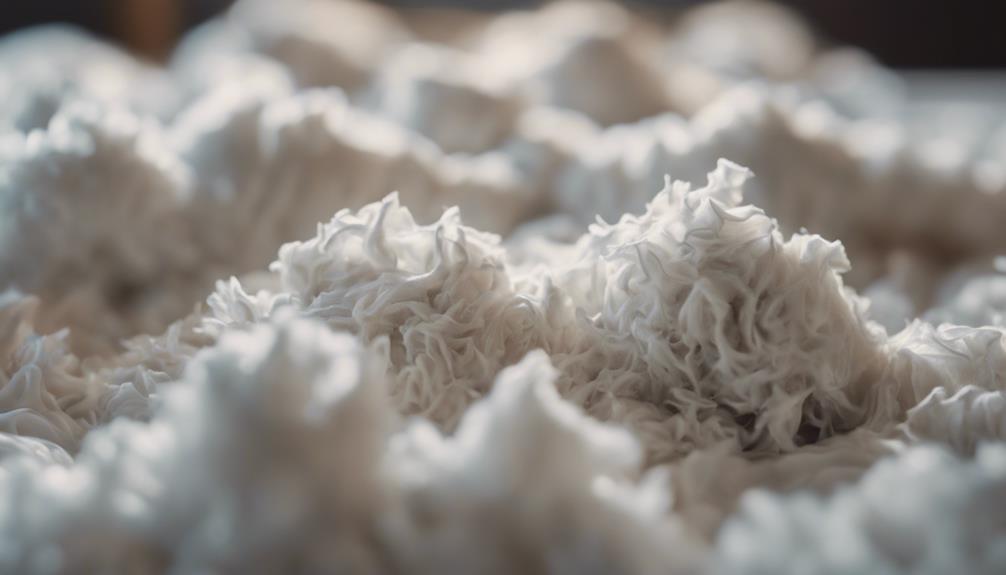
The clumping of fill material in a comforter can lead to a crunchy texture if not addressed properly. When the fill material isn't evenly distributed or if inadequate drying methods are used, clumping can occur, resulting in an uncomfortable feel to the comforter. To prevent this issue, it's essential to follow proper care and drying techniques.
- Ensure Even Distribution: Make sure the fill material is evenly spread out in the comforter before placing it in the dryer to prevent clumping.
- Use Proper Drying Techniques: Employ suitable drying techniques such as using dryer balls or periodically fluffing the comforter during the drying cycle to maintain the fluffiness of the fill material.
- Avoid Improper Care: Refrain from using high heat settings or insufficient agitation, as these practices can contribute to the fill material clumping together and creating a crunchy texture in the comforter.
Fiber Breakdown Over Time
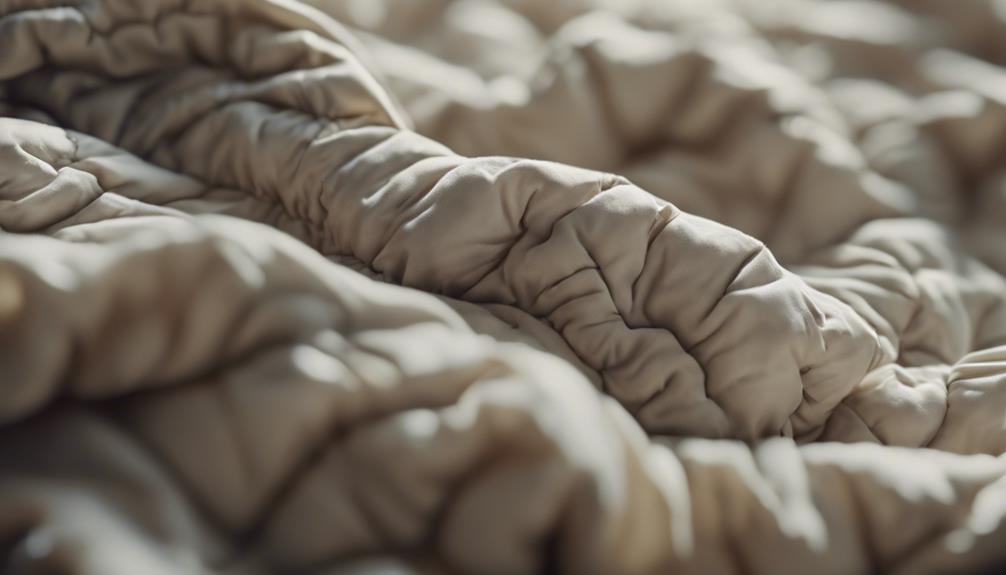
As comforters age, the fibers gradually break down, leading to a crunchy texture that can be attributed to repeated washing and drying cycles. The continuous exposure to the agitation and heat in the dryer can cause the comforter fill to break down over time, resulting in a stiff and crunchy feel. Harsh detergents used during washing can also contribute to this fiber breakdown, making the comforter lose its softness and become less comfortable to sleep under.
In addition to washing and drying, the long-term use of a comforter can lead to fiber breakdown. The fibers within the comforter may become clumpy, and the overall texture can become less fluffy and more compact. This breakdown process can be exacerbated by high heat settings in the dryer, which can melt the comforter fill and further contribute to the crunchy texture.
To avoid this issue, it's essential to consider using gentle detergents, lower heat settings in the dryer, and regular maintenance of your comforter to prolong its lifespan and preserve its softness.
Proper Care and Maintenance
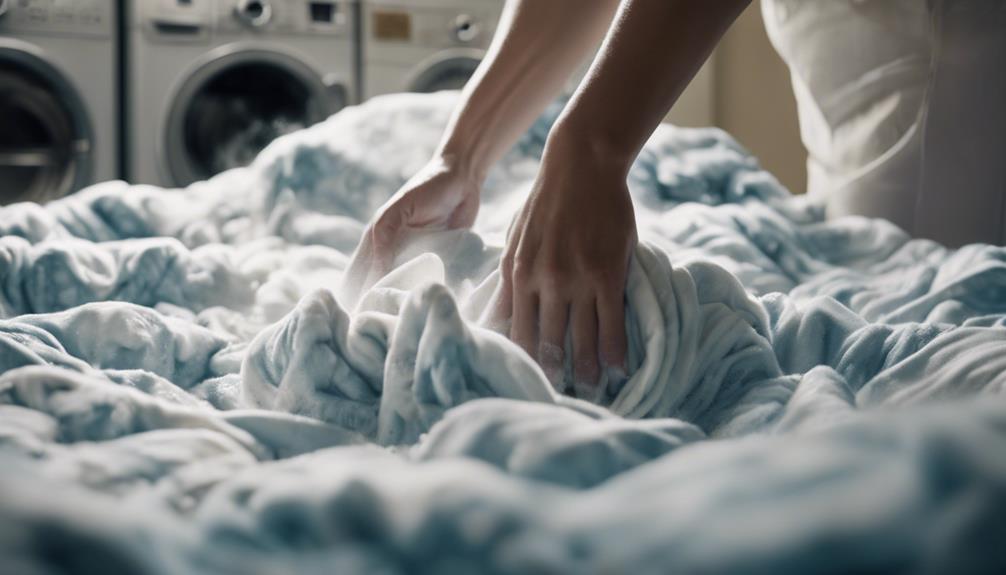
For best comforter care and maintenance, follow the care label instructions provided for washing and drying techniques. When washing your comforter, use a gentle detergent to avoid damaging the fabric and causing it to become crunchy. Avoid overloading the washing machine, as this can lead to clumping and uneven cleaning.
To guarantee your comforter stays soft and fluffy after washing, consider air drying it whenever possible. High heat in the dryer can damage the fibers and contribute to the crunchy texture. If you do use a dryer, add tennis balls or wool dryer balls to help fluff up the comforter and prevent it from becoming crunchy.
Additionally, using fabric softener or dryer sheets can help maintain the softness of your comforter and provide a more comfortable sleeping experience. By following these care and maintenance tips, you can keep your comforter clean, soft, and free of that unwanted crunchiness.
Frequently Asked Questions
How to Fix a Crunchy Comforter?
To fix a crunchy comforter, shake it while drying to prevent clumping. Use less detergent to avoid residue buildup causing stiffness. Refresh wool dryer balls for softness. Consider air drying or using a lower heat setting.
Soak the comforter in a vinegar and water solution to soften the fabric. These steps can help maintain the comforter's fluffiness and prevent crunchiness after washing.
How to Soften a Crunchy Comforter?
To soften a crunchy comforter, try using white vinegar in the rinse cycle for fabric softening. Adding tennis balls or dryer balls to the dryer can fluff up the comforter and reduce stiffness. Opt for a gentle drying setting with low heat to prevent crunchiness.
Consider using fabric softener or dryer sheets for a softer touch. Air drying the comforter outdoors can also help restore softness and remove any remaining stiffness.
Why Are My Blankets Crunchy After Washing?
Blankets can become crunchy after washing due to various factors such as detergent residue, hard water minerals, over-drying, or excessive fabric softener use.
The accumulation of soap and minerals can make blankets stiff and uncomfortable. Overloading the machines may prevent proper rinsing or drying, leading to crunchiness.
To prevent this issue, avoid high heat settings, use dryer balls, and consider re-washing with less detergent or vinegar to restore softness.
Why Did the Stuffing in My Comforter Get Hard?
When the stuffing in your comforter becomes hard, it's often due to over-drying in the dryer. Excessive heat can cause the filling material to clump together and harden. This issue can arise from using high heat settings or leaving the comforter in the dryer for too long.
To prevent crunchy stuffing, follow care instructions, use gentle drying methods, and avoid overheating in the dryer. Proper care can help maintain the fluffiness of your comforter.
Why Does a Down Comforter Become Crunchy After Washing?
After washing, a down comforter sounds crunchy due to the feathers clumping together. Improper drying or inadequate fluffing can cause the feathers to stick, creating a stiff and crunchy texture. To avoid this, ensure the comforter is completely dry and fluff regularly during the drying process.
Conclusion
To sum up, it's crucial to follow proper care and maintenance instructions when washing your comforter to prevent it from becoming crunchy. By avoiding excessive detergent usage, ensuring thorough rinsing, preventing clumping of fill material, and being mindful of fiber breakdown over time, you can maintain the softness and comfort of your bedding.
Remember, just like a delicate flower needs gentle care to bloom beautifully, your comforter needs gentle handling to stay soft and cozy.
Comforter
Why Is My Comforter Stiff After Washing
Lacking softness? Discover why your comforter feels stiff after washing and learn how to restore its fluffiness with expert tips.

If your comforter feels stiff after washing, it may be because of improper drying methods. To keep it soft, avoid high heat settings, opt for gentle cycles, and don’t overload the dryer. Clumped filling can also cause stiffness. Try using tennis or dryer balls to break up the clumps. Following care label instructions is crucial; use the correct detergent and air dry or use low heat. Ensuring proper airflow during drying is important. For more tips on maintaining your comforter’s softness and preventing stiffness, explore further guidance on drying techniques and fluffiness maintenance.
Key Takeaways
- Use low heat settings to prevent stiffness and fabric damage.
- Avoid overloading the dryer for proper air circulation.
- Regularly fluff and redistribute filling to maintain softness.
- Opt for gentle heat settings and proper drying techniques.
- Follow care label instructions for specific fabric care guidance.
Incorrect Drying Techniques

When drying your comforter, we must avoid high heat settings in the dryer to prevent stiffness and maintain its softness. Excessive heat can damage the fabric and strip it of its natural softness. It's important to select a gentle heat setting to make sure that the comforter dries evenly and remains fluffy.
Furthermore, overloading the dryer can hinder proper air circulation, leading to a stiff comforter. To prevent this, make sure the comforter has enough space to move around freely in the dryer. Additionally, using fabric softeners sparingly is advisable, as an excess of these products can leave a residue on the comforter, causing stiffness.
After washing your comforter in the washing machine, be mindful of the drying process. Opt for a low heat setting and consider using dryer balls to help fluff the comforter as it dries. By following these tips and avoiding common mistakes, you can maintain the softness and quality of your comforter for longer periods.
Clumped Filling

When clumped filling occurs in a comforter, the inner materials stick together, causing stiffness and discomfort.
To address this issue, it's essential to focus on proper filling distribution and drying techniques.
Filling Distribution
During the washing and drying process, clumped filling in a comforter can result from the bunching up of the filling material, causing stiffness and discomfort. Uneven distribution of the filling can lead to areas with excess filling and other spots with little to no filling, affecting the overall comfort and warmth of the comforter.
To prevent clumped filling, add a couple of tennis balls or dryer balls to the dryer to help break up the clumps. You can also shake the comforter periodically during the drying cycle. For maintenance, consider adding a small amount of baking soda to the comforter when washing to help loosen any clumps that may have formed over time. Regularly fluffing and redistributing the filling can also help maintain the softness and comfort of the comforter.
Proper Drying Techniques
To prevent clumped filling in your comforter and maintain its softness, using proper drying techniques is essential. Improper drying methods, like high heat settings, can cause the filling to clump together, resulting in a stiff comforter.
To avoid this, consider using dryer balls or clean tennis balls during the drying cycle to help fluff up the filling and prevent clumping, ultimately leading to a softer feel. Opting for air drying or using a low heat setting in the dryer can also help preserve the loftiness of the filling and prevent stiffness.
Remember to gently shake out the comforter during drying to evenly redistribute the filling and prevent it from clumping.
Additionally, avoid overloading the dryer with too many items, as this can compress the filling and make the comforter feel stiff after washing.
Care Label Instructions

By adhering to the care label instructions provided on your comforter, you can guarantee proper washing and drying techniques to maintain its softness and prevent stiffness. Different fabrics and fillings may have specific care requirements to make sure they stay soft after washing.
It's essential to select the right detergent and avoid washing in high heat, as these can contribute to stiffness. Air drying or using a low heat setting in the dryer can help preserve the comforter's softness.
Overloading the washer or dryer should be avoided to ensure thorough cleaning and prevent stiffness from setting in. Care labels offer valuable guidance on how to care for your comforter properly, so be sure to read and follow them diligently.
Proper Dryer Settings

When drying your comforter, remember to select a low heat setting to maintain its softness. High heat can damage the fibers, causing stiffness.
Opting for a gentle cycle and using dryer balls can also help prevent stiffness.
Heat Level Selection
Using the appropriate heat level setting on your dryer can help prevent your comforter from becoming stiff after washing. To maintain the softness of your comforter, it's recommended to use a low heat setting.
High heat settings can damage the fibers, causing the fabric to lose its original texture and comfort. Be cautious not to over-dry your comforter, as excessive heat can lead to stiffness and reduce its overall softness.
Timed Drying Options
To prevent stiffness in your comforter, consider setting the dryer to a low heat or air fluff option. Timed drying options allow you to control the drying duration, reducing the risk of the comforter becoming stiff.
Avoid over-drying, as this can strip the comforter of its softness. Additionally, using dryer balls or clean tennis balls in the dryer can help fluff up the comforter during the drying process, maintaining its plushness.
Always refer to the care label on the comforter for specific drying instructions to prevent stiffness. By following these tips and utilizing timed drying options, you can keep your comforter soft and cozy after each wash.
Use of Tennis Balls

In our quest to maintain the softness and fluffiness of our comforters, incorporating tennis balls into the drying process proves to be a practical and effective solution. Here are some reasons why using tennis balls can help improve the outcome of washing your comforter:
- Fluffing and Redistribution: Tennis balls can help fluff and redistribute the filling in a comforter during the drying process, preventing clumping and maintaining a lofty feel.
- Prevention of Clumping: The bouncing motion of tennis balls in the dryer can prevent clumping and stiffness in the comforter, ensuring an even dry and fluffy result.
- Cost-Effective Solution: Using tennis balls is a cost-effective and easy way to maintain the softness and loft of a comforter without the need for expensive dryer balls or other products.
- Cleanliness Consideration: Make sure to use clean tennis balls to avoid transferring dirt or residue onto the bedding, ensuring a hygienic drying process for your comforter.
Avoid Overloading Dryer

When drying your comforter, make sure the dryer isn't overloaded to prevent stiffness caused by uneven drying. Overloading the dryer can lead to issues such as clumping and stiffness in the comforter because proper air circulation is hindered.
To prevent stiffness, it's important to allow enough space in the dryer for the comforter to move freely during the drying cycle. By reducing the load in the dryer and avoiding overcrowding, you can help maintain the fluffiness and softness of your comforter after washing.
Properly spacing out items in the dryer is essential to ensure even drying and to prevent stiffness from setting in. Remember, a well-aired comforter is a comfortable comforter, so give it the space it needs in the dryer to avoid stiffness and maintain its cozy feel.
Proper Airflow Importance

Proper airflow during the drying process is essential for maintaining the softness of your comforter. Without adequate airflow, moisture can become trapped, leading to stiffness in the fabric.
To prevent this, make sure your comforter has access to good ventilation either by hanging it outside or using a dryer with proper airflow mechanisms.
Airflow and Drying
Ensuring sufficient airflow during the drying process is essential to prevent a comforter from stiffening after washing. Here are four key points to take into account:
- Promotes Even Drying: Adequate airflow helps the comforter dry evenly, preventing certain areas from becoming stiff while others remain damp.
- Prevents Dampness: Insufficient airflow can lead to pockets of dampness in the comforter, which contribute to stiffness as it dries.
- Retains Softness: Hanging the comforter outside or using a well-ventilated dryer promotes airflow, helping the comforter maintain its soft and fluffy texture.
- Avoids Moisture Trapping: Lack of airflow can trap moisture within the comforter fibers, resulting in stiffness and discomfort.
Preventing Moisture Buildup
To maintain a soft and comfortable feel in your comforter after washing, it is essential to prevent moisture buildup by ensuring proper airflow during the drying process. Proper airflow helps to dry the comforter thoroughly, preventing dampness that can lead to stiffness and discomfort. Lack of ventilation can trap moisture in the fibers, causing the comforter to feel stiff. To promote airflow, consider hanging the comforter outside on a clothesline or using a drying rack. Additionally, storing the comforter in a well-ventilated area post-wash can also help maintain its softness. Adequate ventilation in the laundry space is vital for preventing stiffness and ensuring your comforter stays cozy and inviting.
| Importance of Proper Airflow |
|---|
| Prevents Moisture Buildup |
| Promotes Thorough Drying |
| Maintains Softness |
Fluffiness Maintenance Tips

For fluffiness maintenance, tossing a couple of tennis balls or wool dryer balls in with your comforter during drying can help restore its softness and prevent stiffness.
Here are some additional tips to maintain the fluffiness of your comforter:
- Use Low Heat Setting: Opt for a low heat setting when drying your comforter with dryer balls to prevent overheating and potential damage to the fabric fibers.
- Shake Before Drying: Before placing the comforter in the dryer, shake it out to guarantee even distribution and prevent clumping, which can lead to stiffness.
- Avoid Overloading: To allow the comforter to move freely and regain its fluffiness, avoid overloading the dryer with too many items that may restrict movement.
- Regular Fluffing: Periodically remove the comforter from the dryer and fluff it by hand to maintain its loftiness and prevent it from becoming flat or stiff over time.
Tennis Balls Vs. Dryer Balls

When comparing tennis balls to dryer balls for maintaining the fluffiness of your comforter, consider the differences in noise levels and fabric gentleness.
Tennis balls are commonly used to help fluff and redistribute the filling in a comforter during the drying process. While they can be effective, they tend to create loud noises in the dryer due to their hard texture.
On the other hand, dryer balls, which are typically made of wool or plastic, work similarly to tennis balls but are designed to be gentler on fabrics. They not only reduce drying time and static but also offer a quieter laundry experience.
Dryer balls are known for being more gentle on delicate fabrics compared to the potential roughness of tennis balls. Both options can help maintain the loftiness of your comforter, but dryer balls may provide additional benefits such as a softer touch and reduced noise during the drying cycle.
Ensuring Even Drying

After discussing the benefits of using dryer balls or tennis balls for maintaining the fluffiness of your comforter, the focus now shifts to guaranteeing even drying to prevent stiffness.
To achieve best results and keep your comforter soft and cozy, follow these steps:
- Make sure to dry the comforter thoroughly to prevent stiffness. This will help eliminate any residual moisture that could lead to a stiff texture.
- Ensure the comforter is evenly distributed in the dryer for consistent drying. This will help all areas of the comforter dry evenly and prevent certain spots from becoming stiff.
- Use dryer balls or clean tennis balls to fluff the comforter during drying. These items can help maintain the fluffiness and prevent clumping, resulting in a softer comforter.
- Avoid overloading the dryer to allow proper airflow for even drying. Overloading the dryer can lead to uneven drying and potential stiffness. Shake out the comforter periodically during the drying process to prevent clumping and stiffness.
Frequently Asked Questions
How to Soften a Stiff Comforter?
To soften a stiff comforter, try adding white vinegar to the rinse cycle to break down residue. Use a tennis ball or dryer ball in the dryer to fluff it up.
Air dry outside on a sunny day to naturally soften the fabric. Toss a clean, damp washcloth in the dryer with the comforter for added moisture.
Consider using bedding-specific fabric softener for extra softness and a fresh scent.
How Do I Make My Comforter Soft Again?
To make your comforter soft again, try using fabric softener in the wash. It restores softness and helps prevent stiffness.
Use dryer balls or clean tennis balls when drying to fluff up the comforter. Air-drying also maintains softness.
Adding dryer sheets can further soften it. For even better results, toss the comforter with a damp towel in the dryer to loosen the fibers.
These methods will guarantee your comforter stays cozy and soft.
Why Did the Stuffing in My Comforter Get Hard?
When the stuffing in a comforter becomes hard after washing, it's often due to insufficient drying time, causing clumping and hardening of the filling.
Overloading the dryer or using high heat settings can lead to uneven drying and stiffness.
If there's not enough air circulation during drying, moisture can get trapped in the filling, resulting in hardness.
Avoid using harsh detergents or fabric softeners that can leave residues contributing to stiffness.
How to Fix a Crunchy Comforter?
When dealing with a crunchy comforter, consider adding tennis balls or dryer balls in the dryer to fluff and redistribute the filling evenly. Opt for a lower heat setting to maintain softness, and toss in a few clean, dry towels to help absorb excess moisture. Shake out the comforter during drying to prevent clumping.
Avoid overloading the dryer to allow free movement. These steps can help restore your comforter's plushness and prevent stiffness.
What Causes Comforters to Become Stiff and Crunchy After Washing?
After washing, a crunchy comforter can result from detergent residue. To fix this issue, consider using less detergent and adding vinegar to the rinse cycle. Additionally, using wool dryer balls or tennis balls can help fluff up the comforter during drying. Following these steps can lead to a softer outcome.
Conclusion
To sum up, ensuring your comforter maintains its softness after washing requires proper care and attention to detail.
By following the correct drying techniques, using tennis balls, and ensuring even airflow, you can keep your comforter fluffy and cozy.
Remember, taking care of your comforter is like tending to a delicate garden – with the right tools and techniques, you can enjoy its warmth and comfort for years to come.
Comforter
Why Does My Down Comforter Sound Crunchy
Discover why your down comforter sounds crunchy, as the unique structure of down feathers and cleaning methods may hold the key.

Down comforters may sometimes make a crunchy sound because of the unique structure of down feathers. It is important to thoroughly clean the comforter and remove any quills in order to maintain softness. Lower quality comforters may contain noisy feathers due to the way they are processed. The quality of the processing can impact the functionality of the comforter. The type of fabric and the tightness of the weave can also affect the sound of the comforter. Cambric cotton is down-proof, while batiste weaves may sound crunchier. Moisture and stiff cotton can also contribute to the crunchiness. Protective coatings and synthetic fabrics can add to the noise as well. Dry cleaning and fabric softener can help reduce the crunchiness. Using duvet covers can offer protection and provide an easy way to change the decor of a room. For more information on how to maintain the fluffiness of your comforter and reduce noise, please refer to the details below.
Key Takeaways
- Quill removal eliminates crunchiness in down comforters by removing stiff structures that create noise.
- Tight weaving in cambric cotton covers reduces noise by creating fewer air pockets.
- Moisture trapped in comforters causes clumping; ensure thorough drying to prevent crunchiness.
- Fabric softener reduces crunchiness by enhancing softness and comfort in down comforters.
- Protective coatings can contribute to crunchiness; opt for waterproof coatings that soften over time.
Nature of Down Feathers
When we handle down feathers, we can immediately notice the inherent crinkle sound they produce due to their unique structure. The quills and barbs on down feathers are responsible for making the noise, creating a distinct crunchy sound when compressed.
This natural crinkle is what gives down comforters their signature rustling texture. The fine, airy structure of down clusters further enhances this auditory experience, with the movement of air within the clusters contributing to the overall sensation.
The softness and fluffiness of down feathers, while providing exceptional comfort, also play a role in the pleasant crinkling feeling when pressed. Understanding the nature of down feathers helps us appreciate why down comforters sound crunchy and why they're favored for their unique texture.
Quality of Down Processing

In high-quality down processing, ensuring thorough cleaning and removal of quills is essential to avoid the crunchy texture in down comforters. The presence of feather quills can lead to the crunchy sounds that disrupt your comfort. Lower quality processing may result in these unwelcome textures, indicating a mix of feathers within the down. To better understand the importance of quality processing, let's take a closer look at how it affects the overall comfort of your bedding:
| Quality of Down Processing | Effects on Comforters | Importance |
|---|---|---|
| Thorough cleaning | Soft and fluffy | High |
| Quill removal | Eliminates crunchiness | High |
| Feathers presence | Makes noise | Low |
Quality down processing directly impacts the comfort and functionality of your down comforter. By ensuring proper cleaning and quill removal, you can enjoy a quieter and more luxurious sleeping experience.
Fabric Covering Material

When it comes to the fabric covering material of down comforters, understanding different fabric types is essential.
The specific fabric used can play a significant role in the crunchy sound experienced.
Fabric Types Explained
Covering materials for down comforters play an important role in ensuring the quality and durability of the bedding. Cambric cotton, known for its high down-proof nature, is a popular choice for duvet covers. Batiste weave, another common fabric, is thinner and tends to make more noise compared to cambric.
The crinkle sound in cambric cotton bedding decreases over time with usage and washing. Additional factors like fabric finishing and natural skin oils can help soften the audible crinkle in cambric cotton bedding. The crinkle noise signifies quality down-proofing and typically diminishes with prolonged use, ultimately enhancing comfort and warmth.
It's crucial to keep these fabric types in mind when selecting a down comforter for a cozy night's sleep.
Crunchiness Causes Identified
The material chosen for a down comforter's cover plays a significant role in determining its crunchiness. Stiff cotton materials, especially when new, can make the comforter sound crunchy. The tight weave used in sewing the comforter might also contribute to this noise.
Additionally, adding a protective coating like waterproof material could lead to a crunchy sound. Synthetic fabrics such as microgel, commonly found in comforters, might make them sound crunchy too, especially when they're freshly bought.
When thinking about why your down comforter sounds crunchy, consider the covering material as a potential culprit. The type of fabric used can have a notable impact on the sound it produces, so the choice of covering material is important in determining the crunchiness of your comforter.
Maintenance Tips Suggested
Our tips focus on maintaining the fabric covering material of your down comforter to reduce crunchiness and enhance comfort. To soften the crunchiness in cambric cotton, wash the comforter regularly following the manufacturer's instructions.
The crinkle sound will diminish over time with usage and proper care. Skin contact and natural skin oils can also help soften the fabric, further reducing the crinkle noise. Remember that the crinkle reduction is a natural process as the fabric softens with time in down bedding.
Opting for cambric cotton fabric is beneficial as it's highly down-proof, preventing down leakage and indicating quality in your bedding. By following these maintenance tips, you can enjoy a softer, less crunchy down comforter.
Impact of Weaving Tightness

When considering the impact of weaving tightness on down comforters, one can observe a direct correlation between the tightness of the weave and the level of noise produced.
A tight weave used in sewing down comforters can result in a puffed-up appearance, creating more air pockets within the comforter. These air-filled pockets, when trapped within a tight weave, tend to produce more sound when the comforter is moved or adjusted.
The tightness of the weave plays a significant role in determining the noise level of the comforter. Sewing with a tight weave prevents air from easily escaping, which can contribute to the crunchy or noisy sound often heard when using these comforters.
Hence, the puffed-up nature of comforters with a tight weave can make them noisier compared to those with a looser weave. This connection between weaving tightness and the sound produced highlights the importance of weave density in the overall comforter quality and user experience.
Protective Coating Presence

When examining down comforters, it's crucial to take into account the presence of protective coatings. These coatings, often made of waterproof materials with polymer layers, can contribute to the crunchy sound of the comforter.
Over time, the noise from the coating may reduce as it gets broken in with use.
Coating Impact
The presence of a protective coating on down comforters, such as waterproof material, can lead to the production of a crunchy sound when the comforter is moved. Here are three ways this coating impacts the overall experience:
- Initial Noise: The coating, often made of two layers of polymer, can cause the comforter to sound crunchy when first used.
- Protection Benefits: While the coating protects the down from liquid stains and pests, it may create noise initially.
- Softening Over Time: The crunchy sound from the waterproof materials can diminish with continued use as they soften.
Understanding how the protective coating affects the noise level of a down comforter can help users anticipate and manage the crunchy sound.
Noise Reduction
Incorporating noise reduction techniques can enhance the comfort of down comforters adorned with protective coatings such as waterproof materials. These coatings, often made of two layers of polymer, aim to shield the down from liquid stains and pests. However, they can introduce unwanted noise, especially when the comforter is new.
The crinkling sounds produced by waterproof materials tend to decrease with use over time. To reduce this noise, consider opting for down comforters with specialized noise-reducing coatings or washing the comforter to soften the protective layer. By implementing these noise reduction methods, you can enjoy the benefits of a protected down comforter without the distracting crunchiness.
Synthetic Fabric Usage

Exploring the use of synthetic fabrics in down comforters reveals their potential contribution to the distinctive crunchy sound often associated with these bedding items. Synthetic fibers like microgel, commonly used in down comforters, can create a crinkly or crispy noise due to their non-biodegradable nature. Additionally, the initial noise from comforter covers made with synthetic materials may diminish as the fabric softens over time. Microgel comforters, favored for their durability and water resistance, may exhibit a crunchy sound when new, attributed to the synthetic nature of the fibers. The type of synthetic fabric utilized in the cover of down comforters can also influence the noise levels produced.
- Synthetic fibers, such as microgel, contribute to the crunchy sound in down comforters.
- The noise from comforter covers with synthetic fabrics may decrease as the material softens.
- Microgel comforters, known for durability, exhibit a distinct crunch when new due to their synthetic composition.
Moisture Trapped in Comforter

When moisture gets trapped in a down comforter, it can cause the filling to clump together and create a crunchy sound.
To guarantee this, it's important to make sure proper ventilation and drying techniques are used regularly.
Excess Moisture Contributes
Excess moisture trapped in a down comforter contributes to the crunchy sound experienced when moving or adjusting the bedding. Here are three reasons why moisture can lead to this unpleasant sensation:
- Clumping of Down Clusters: The presence of moisture causes the down clusters to stick together, creating a crunchy texture.
- Accumulation Sources: Moisture can come from various sources like perspiration, high humidity, or inadequate drying after washing.
- Preventive Measures: To avoid excess moisture buildup, make sure the comforter is fully dry before using it and store it in a dry environment to maintain its fluffiness and softness.
Drying Techniques Recommended
To effectively address moisture trapped in a down comforter, it's essential to employ proper drying techniques that promote fluffiness and prevent clumping. Thoroughly drying the comforter in a large capacity dryer is pivotal. Use low heat and add dryer balls or clean tennis balls to help fluff and distribute the down evenly.
Regularly check and shake the comforter during the drying process to prevent clumping and moisture retention. Avoid air drying, as trapped moisture can lead to the crunchy sound. Properly dried down comforters maintain their loftiness and softness without the crunchy texture.
Dry Cleaning Solution

Dry cleaning is a recommended method for maintaining the fluffiness and cleanliness of down comforters. When it comes to caring for your down comforter, here are three key reasons why dry cleaning is a great solution:
- Preserves Fluffiness: Dry cleaning helps to maintain the loft and fluffiness of the down filling by gently removing dirt and oils that can weigh it down. This guarantees your comforter stays light and airy.
- Avoids Damage: Washing down comforters at home can sometimes cause damage due to the agitation and water exposure. Dry cleaning avoids these risks, keeping your comforter in top condition for longer.
- Removes Allergens: Professional dry cleaning can effectively eliminate dust, dirt, and allergens that may have accumulated in your comforter. This is especially beneficial for individuals with allergies or sensitivities.
Fabric Softener Addition

To enhance the softness and reduce the crunchiness of a down comforter, incorporating fabric softener during the washing process can be a beneficial step. Adding fabric softener to the wash helps soften the fabric of the comforter, reducing stiffness in the cotton covering and minimizing the crunchy sound.
The softened fabric from the fabric softener not only improves the overall feel of the comforter but also reduces noise levels. By incorporating fabric softener in the wash cycle, you can enhance the comforter's texture and reduce crinkling.
Fabric softener works by breaking down any stiffness in the fabric, resulting in a softer, less crunchy feel overall. So, if you're looking to make your down comforter more comfortable and less noisy, consider adding fabric softener to your washing routine to enjoy a softer, cozier night's sleep.
Duvet Cover Benefits

When considering the benefits of duvet covers, one can't overlook their multifunctional role in enhancing both the aesthetic appeal and practicality of bedding. Duvet covers offer a myriad of advantages:
- Protection: Duvet covers shield the down comforter from dirt, stains, and wear, thereby extending its lifespan.
- Versatility: They provide a quick and effortless way to change the look of your bedding and room decor, allowing for easy style updates.
- Customization: Available in various colors, patterns, and materials, duvet covers cater to a wide range of style preferences, ensuring you can find the perfect match for your taste.
Duvet covers not only add a layer of warmth and coziness, especially during colder months, but they're also convenient to clean and maintain since they're machine washable. These benefits make duvet covers a practical and stylish addition to any bedding ensemble.
Frequently Asked Questions
How to Fix a Crunchy Comforter?
To fix a crunchy comforter, try washing it to soften the fabric and reduce the noise. Natural skin oils and regular use can also help soften the fabric over time.
Opt for a down-proof fabric like cambric cotton to prevent down leakage and reduce noise. Using a duvet cover can muffle the sound and enhance overall comfort.
These steps can make your comforter feel cozy and quiet for a better night's sleep.
Why Is My Down Comforter Crinkly?
When we hear a down comforter sounding crunchy, it's often due to the high-quality cotton material used in the cover. The tight weave sewing techniques can make the comforter puffed up and noisy.
Sometimes, a protective coating like waterproof material can also contribute to the crinkly sound. Additionally, comforters made with synthetic fabrics, such as microgel, may produce noise when new.
The type of material covering the down and the tightness of the weave can impact the crunchiness of a down comforter.
What Makes a Duvet Crunchy?
When we talk about what makes a duvet crunchy, it usually comes down to the type of fabric used in the cover. The material's tight weave or coatings like waterproof layers can contribute to that crunchy sound.
Even synthetic fabrics like microgel can add to the crunchiness. The level of crunchiness can vary based on the materials and construction of the duvet.
It's all about the fabric and how it's put together.
Why Does My Feather Duvet Make a Noise?
Our feather duvet might make noise due to the cover's stiff cotton, tight sewing, or a protective coating.
Synthetic fabrics like microgel can also contribute to the crunchy sound. The type of material covering the down, weave tightness, and protective coatings all play a role in the noise.
These factors come together to create the signature crunchy sound in our feather duvets.
Is the Crunchy or Noisy Sound of My Down Comforter Normal?
The noisy down comforter reasons can vary, but it’s generally considered normal for down comforters to produce some level of crinkling or crunching sound when being moved. This is usually a result of the natural materials used in the comforter, such as the down feathers or the fabric cover.
Conclusion
To sum up, the crunchiness of your down comforter can be attributed to various factors such as the nature of down feathers, quality of processing, fabric material, weaving tightness, and moisture trapped within.
To soften your comforter, consider dry cleaning, using fabric softener, or adding a duvet cover for extra protection.
Remember, a cozy and smooth comforter is key to a good night's sleep, so take care of your bedding for ultimate comfort.
Mason – Your Product Expert Mason is your go-to product expert, carefully selecting each item in our collection to ensure it meets your comfort, functionality, and style needs. With his attention to detail and commitment to quality, he ensures that every product we offer enhances your home experience.
-
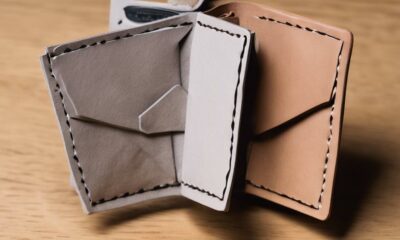
 Vetted6 months ago
Vetted6 months ago14 Best Personalized Father's Day Gifts for Your Husband – Show Him You Care
-

 Alfresco5 months ago
Alfresco5 months agoAlfresco Stacker Doors: Seamless Indoor-Outdoor Living!
-

 Vetted7 months ago
Vetted7 months ago15 Best EMS Foot Massagers for Neuropathy to Soothe Your Feet
-

 Craft and Textiles7 months ago
Craft and Textiles7 months ago15 Best Places to Buy Appliances for Your Home – Top Retailers Reviewed
-

 Tableware and Dining Accessories7 months ago
Tableware and Dining Accessories7 months agoWhat Is the Meaning of the Word Tableware
-
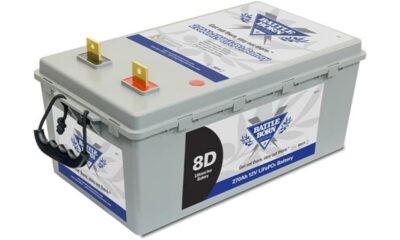
 Vetted5 months ago
Vetted5 months agoBattle Born Batteries Review: Reliable Power Solution
-

 Vetted5 months ago
Vetted5 months agoD-Link Switch Review: Lite Layer 3 Managed Networking
-

 Tableware and Dining Accessories7 months ago
Tableware and Dining Accessories7 months agoWhen Is Tableware on Sale at Hobby Lobby





























